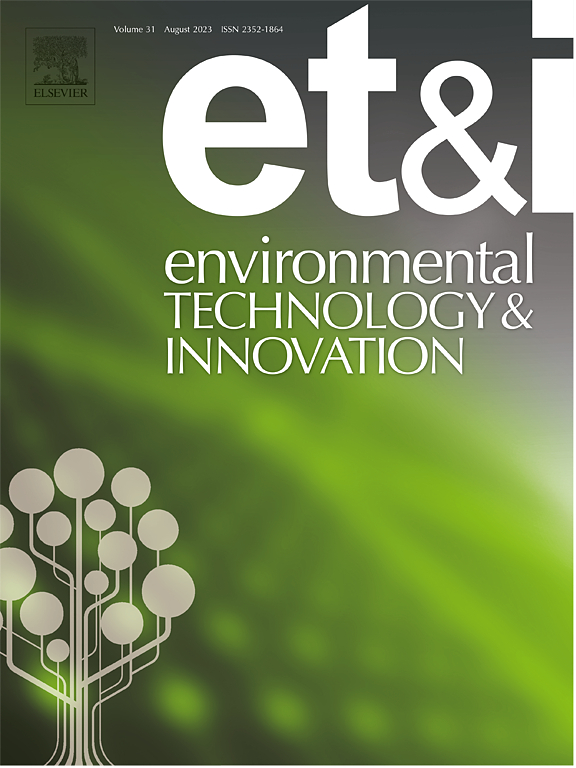Solar light-responsive g-C₃N₄ and Ni₁₋ₓMnₓCo₂₋ᵧFeᵧO₄ composites for rapid dye degradation and phytotoxicity evaluation
IF 6.7
2区 环境科学与生态学
Q1 BIOTECHNOLOGY & APPLIED MICROBIOLOGY
引用次数: 0
Abstract
A series of Ni1-xMnxCo2-yFeyO4/g-C3N4 composites were prepared by co-precipitation and ultra-sonication approaches and the effect of Mn and Fe substitution and g-C3N4 addition was explored based on structural, dielectric, ferroelectric, optical and photocatalytic properties. The X-ray diffraction analysis confirmed the formation of a cubic structure with a particle size range of 28–35 nm of cobaltites (spinel structure). The grain size enhancement through Mn and Fe substitution was observed and the dielectric constant decreased as the frequency increased. The tangent loss was used to measure the energy loss in dielectric relaxation. The P-E loop shows enhanced coercivity (12.25 kV/cm), saturation polarization (7.72 ×10−3 Ps (μC/cm2) and remnant polarization (7.6 ×10−3 μC/cm2) for highly substituted nanocomposite. The PL analysis revealed the low recombination rate of h+-e- and bandgap declined from 1.62 to 1.16 eV for the highly substituted NiCo2O4/g-C3N4 nanocomposite. Crystal violet dye was degraded under solar light exposure and Ni1-xMnxCo2-yFeyO4/g-C3N4 exhibited a higher photocatalytic performance versus NiCo2O4/g-C3N4. The recyclability and reusability of the nanocomposite were assessed and the Ni1-xMnxCo2-yFeyO4/g-C3N4 showed promising stability. The Zea mays germination (%), root length (cm) and shoot length (cm) were compared, and the treated dye revealed significantly lower phytotoxicity versus the untreated dye solution. Results revealed that the Ni1-xMnxCo2-yFeyO4/g-C3N4 composites have the potential for photocatalytic applications under solar light irradiation, which will make the process more economical versus other photocatalytic processes.
太阳光响应性g-C₃N₄和Ni₁瞪瞪瞪瞪瞪瞪瞪瞪瞪瞪瞪瞪瞪瞪瞪瞪瞪瞪瞪瞪瞪瞪瞪瞪瞪瞪瞪瞪
采用共沉淀法和超声波法制备了一系列Ni1-xMnxCo2-yFeyO4/g-C3N4复合材料,并从结构、介电、铁电、光学和光催化性能等方面考察了Mn、Fe取代和g-C3N4添加对复合材料的影响。x射线衍射分析证实形成了立方结构的钴酸盐(尖晶石结构),粒径范围为28-35 nm。Mn和Fe取代后晶粒尺寸增大,介电常数随频率增加而减小。切线损耗用于测量介质弛豫过程中的能量损失。高取代纳米复合材料的P-E环的矫顽力(12.25 kV/cm)、饱和极化(7.72 ×10−3 Ps (μC/cm2)和残余极化(7.6 ×10−3 μC/cm2)增强。PL分析表明,高取代NiCo2O4/g-C3N4纳米复合材料的h+-e-复合率和带隙从1.62 eV下降到1.16 eV。晶体紫染料在日光照射下降解,Ni1-xMnxCo2-yFeyO4/g-C3N4比NiCo2O4/g-C3N4表现出更高的光催化性能。结果表明,Ni1-xMnxCo2-yFeyO4/g-C3N4具有良好的稳定性。比较了玉米发芽率(%)、根长(cm)和茎长(cm),发现处理后的染料溶液的植物毒性显著低于未处理的染料溶液。结果表明,Ni1-xMnxCo2-yFeyO4/g-C3N4复合材料在太阳光照下具有潜在的光催化应用潜力,与其他光催化工艺相比,该工艺更具经济性。
本文章由计算机程序翻译,如有差异,请以英文原文为准。
求助全文
约1分钟内获得全文
求助全文
来源期刊

Environmental Technology & Innovation
Environmental Science-General Environmental Science
CiteScore
14.00
自引率
4.20%
发文量
435
审稿时长
74 days
期刊介绍:
Environmental Technology & Innovation adopts a challenge-oriented approach to solutions by integrating natural sciences to promote a sustainable future. The journal aims to foster the creation and development of innovative products, technologies, and ideas that enhance the environment, with impacts across soil, air, water, and food in rural and urban areas.
As a platform for disseminating scientific evidence for environmental protection and sustainable development, the journal emphasizes fundamental science, methodologies, tools, techniques, and policy considerations. It emphasizes the importance of science and technology in environmental benefits, including smarter, cleaner technologies for environmental protection, more efficient resource processing methods, and the evidence supporting their effectiveness.
 求助内容:
求助内容: 应助结果提醒方式:
应助结果提醒方式:


